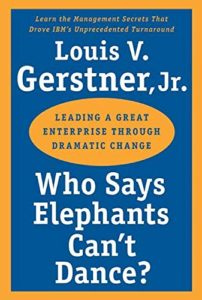Stefan
Latest posts by Stefan (see all)
- Making Every Marketing Dollar Count - March 31, 2025
- The Future-Ready PM: From Traditional Leader to AI-Native Strategist - March 27, 2025
- The Future of Product Management – Fireside Chat with Google PM Stefan F Schnabl - February 14, 2025
TL;DR
My key takeaways from Lou Gerstner’s book ‘Who Says Elephants Can’t Dance?’ are:
- Focus on the fundamentals of a business
- If you are not beating competition, you are doing something wrong
- Incentives need to be aligned to foster the action required
The details:

I am currently doing a course on leadership via Coursera called ‘Leadership in 21st Century Organizations‘ by the Copenhagen Business School. The course has shown me some interesting aspects of leadership, and definitely revealed the complexities of leadership in our times.
While the course presents the topic of leadership in context of general industries, and uses a specific case study from the aviation industry, my interest is often going back to leadership in technology companies. Technology companies pose specific challenges, as most of what is true for ‘classic’ industries seems to be amplified, or accelerated: the pace of change, the pace of new technologies, the change in user behavior, the competitive landscape, etc.
During the course the instructors referenced the book ‘Who Says Elephants Can’t Dance?: Leading a Great Enterprise Through Dramatic Change‘ by Lou Gerstner. Looking for a new read after finishing ‘Into Thin Air‘ by Jon Krakauer (a MUST read), I decided to pick up Lou’s book about IBM’s near downfall, and the amazing perspective Lou shared as CEO of a once-in-a-lifetime turnaround.
In his book, Lou cements what would later become one of his signature statements:
“The thing I have learned at IBM is that culture is everything. “
Lou Gerstner
One of the most important takeaways from the book for me is that change comes from action. And that actions require incentives. So if one understands the role of a CEO to enable and facilitate action, that a lot of how these actions can be influenced has to do with setting up the right incentives. One example is how he helped many regional business leaders to see their contributions to the overall IBM as a whole: he simply reduced compensation based on regional success from the schemes. The more senior the lead, the more of his or her salary was derived from the overall success of IBM.
While Lou made some drastic changes that must have felt like an attack by many employees (i.e. redoing the company health plans), he always made a conscious point to case a wide net of inclusion in how he presented those topics. Framing the changes as ‘This is a journey we are all on, for a higher goal / purpose (i.e. saving the company), which will require us to look at how we can do things differently, and it needs all our collective power and ability.’ invites people to follow along. It defines a higher goal for people they can rally behind, and unlocks meaning and purpose for people, which is known to be a more relevant reward than money to most.
My key takeaways from Lou’s book are:
- Focus on the fundamentals of a business
Are we building the right product for our customers? Are we generating value and having impact in the marketplace? What is the sentiment of our customers around our products? - If you are not beating competition, you are doing something wrong
The idea that something – not clear or concrete – will make you survive as a business if your customers prefer to buy from your competitors is wrong. It is wrong and needs to be rejected. The value generated with customers is a key metric to measure when thinking about business success. - Incentives need to be aligned to foster the action required
Without incentives it is not possible to expect the actions needed form the leadership teams that will drive lasting change. Lou did manage to implement some significant changes to incentives, directed at the changes in behavior which ultimately led to the desired turnaround.